
Hibiscus rosa-sinensis, known colloquially as Chinese hibiscus, China rose, Hawaiian hibiscus,, rose mallow and shoeblackplant, is a species of tropical hibiscus, a flowering plant in the Hibisceae tribe of the family Malvaceae. It is widely cultivated in tropical and subtropical regions, but is not known in the wild, so that its native distribution is uncertain. An origin in some part of tropical Asia is likely.

Gagea lutea, the yellow star-of-Bethlehem, is a Eurasian flowering plant species in the family Liliaceae. It is widespread in central Europe with scattered populations in Great Britain, Spain and Norway to Siberia and Japan.

Chlorophytum, is a genus of almost 200 species of evergreen perennial flowering plants in the century plant subfamily within the asparagus family. The plants are native to the tropical and subtropical regions of Africa, Australia, and Asia.
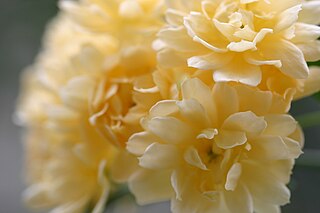
Rosa banksiae, common names Lady Banks' rose, or just Banks' rose, is a species of flowering plant in the rose family, native to central and western China, in the provinces of Gansu, Guizhou, Henan, Hubei, Jiangsu, Sichuan and Yunnan, at altitudes of 500–2,200 m (1,640–7,218 ft). The rose is named for Dorothea Lady Banks, the wife of the botanist Sir Joseph Banks.
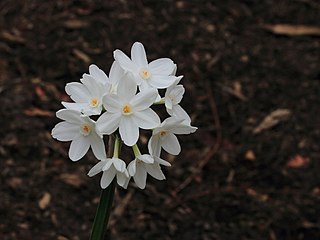
Narcissus papyraceus, one of a few species known as paperwhite, is a perennial bulbous plant native to the Mediterranean region, from Greece to Portugal plus Morocco and Algeria. The species is considered naturalized in the Azores, Corsica, Texas, California and Louisiana. The white flowers are borne in bunches and are strongly fragrant. It is frequently grown as a house plant, often forced to flower at Christmas.

Eremophila maculata, also known as spotted emu bush, or spotted fuchsia-bush is a plant in the figwort family, Scrophulariaceae and is endemic to Australia. It is the most widespread of its genus in nature and probably the most frequently cultivated Eremophila. It is a spreading, often densely branched shrub with variable leaf shape and flower colour, but the other features of the flowers such as the size and shape of the parts are consistent. The inside of the flower is often, but not always spotted.
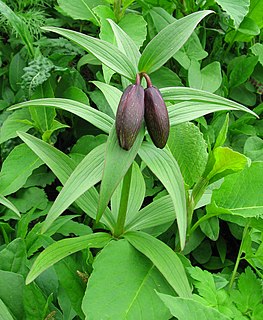
Fritillaria camschatcensis is a species of fritillary native to northeastern Asia and northwestern North America, including northern Oregon, Washington, British Columbia, Alaska, northern Japan, and the Russian Far East. It has many common names, typically Kamchatka fritillary or Kamchatka lily.

Sternbergia is a genus of Eurasian and North African plants in the Amaryllis family, subfamily Amaryllidoideae.

Erigeron glaucus is a species of flowering plant in the daisy family known by the common name seaside fleabane, beach aster, or seaside daisy.

Moraea bituminosa is a species of the genus Moraea in family Iridaceae.
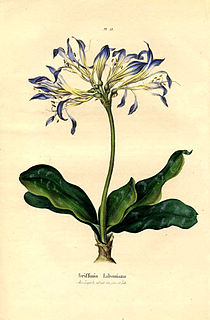
Griffinia is a genus of Brazilian plants in the Amaryllis family, subfamily Amaryllidoideae. It includes 21 known species which are endemic to Brazil in South America. The most closely related genus to it is the monotypic Worsleya.

Allium stellatum, the autumn onion or prairie onion, is a North American species of wild onion native to central Canada and the central United States. It ranges from Ontario and Saskatchewan south to Tennessee and Texas.

Tacca integrifolia, the white batflower, is a species of flowering plant in the yam family, Dioscoreaceae, native to tropical and subtropical rainforests of Central Asia. It was first described by the English botanist John Bellenden Ker Gawler in 1812.

Lilium pensylvanicum is an Asian species of plants belonging to the family Liliaceae. Sometimes called the Siberian lily, it is native to a cold climate and needs frost in the winter. It is found in the wild form in Siberia, the Russian Far East, Mongolia, northeast China, Korea and Hokkaidō.
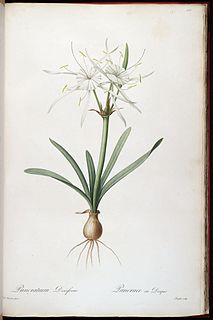
Hymenocallis rotata is a plant in the family Amaryllidaceae, endemic to the north-central portions of the US state of Florida. It is found along the banks of spring-fed streams in the region.
Iris flavescens, also known as the lemonyellow iris, is a species of Iris that has distichous leaves and pale yellow flowers. It is similar in appearance to Iris sambucina, although with flowers that are more faded in colour. It can be found in Pennsylvania, United States.

Lophiola is a genus of monocotyledonous flowering plants native to eastern North America. It has variously been placed in the Liliaceae, the Haemodoraceae, the Tecophilaeaceae or the Nartheciaceae.
Rubus reflexus is a Chinese species of brambles in the rose family. It has been found only in China.

Romulea tortuosa is a herbaceous perennial geophyte in the family Iridaceae native to South Africa. It has a small corm in the soil, a few prostrate coiling leaves, and fragrant, trimerous yellow flowers, sometimes with six brown blotches on the inside near the bottom of the flower.



















